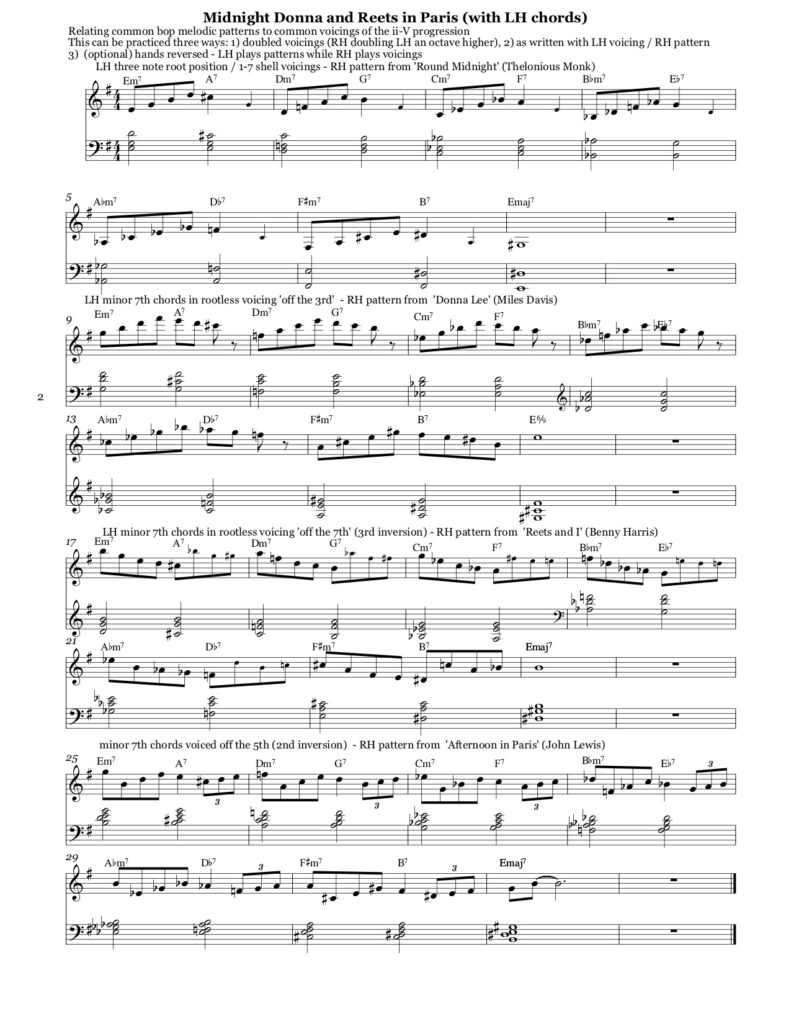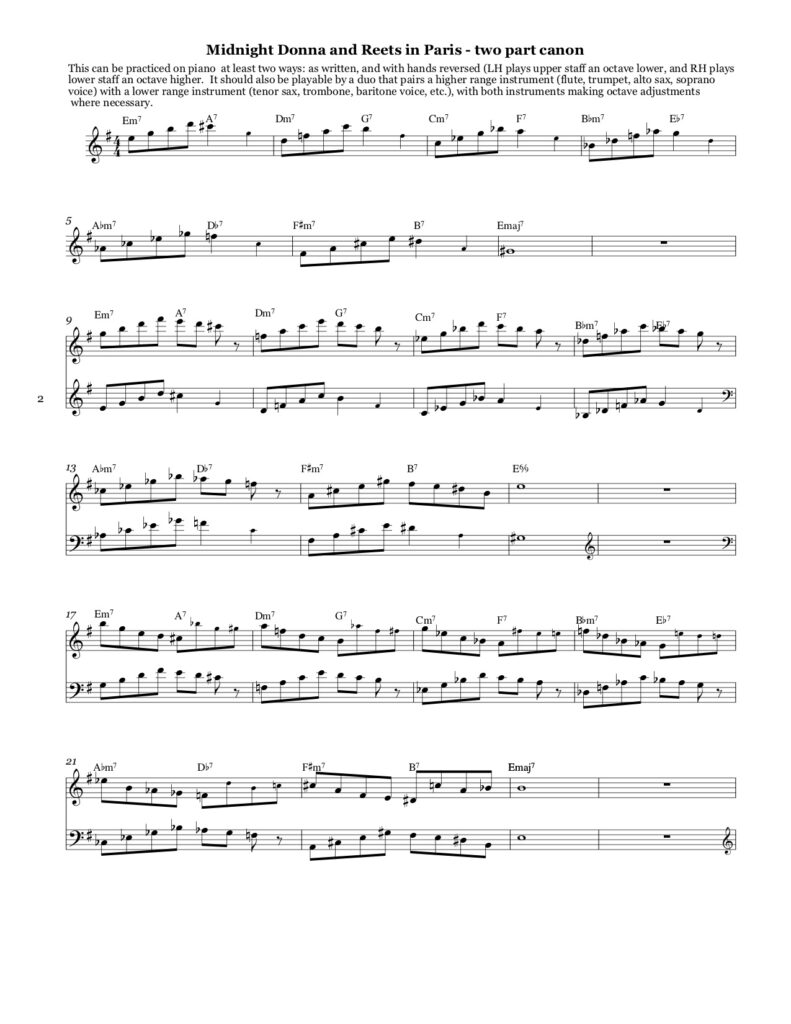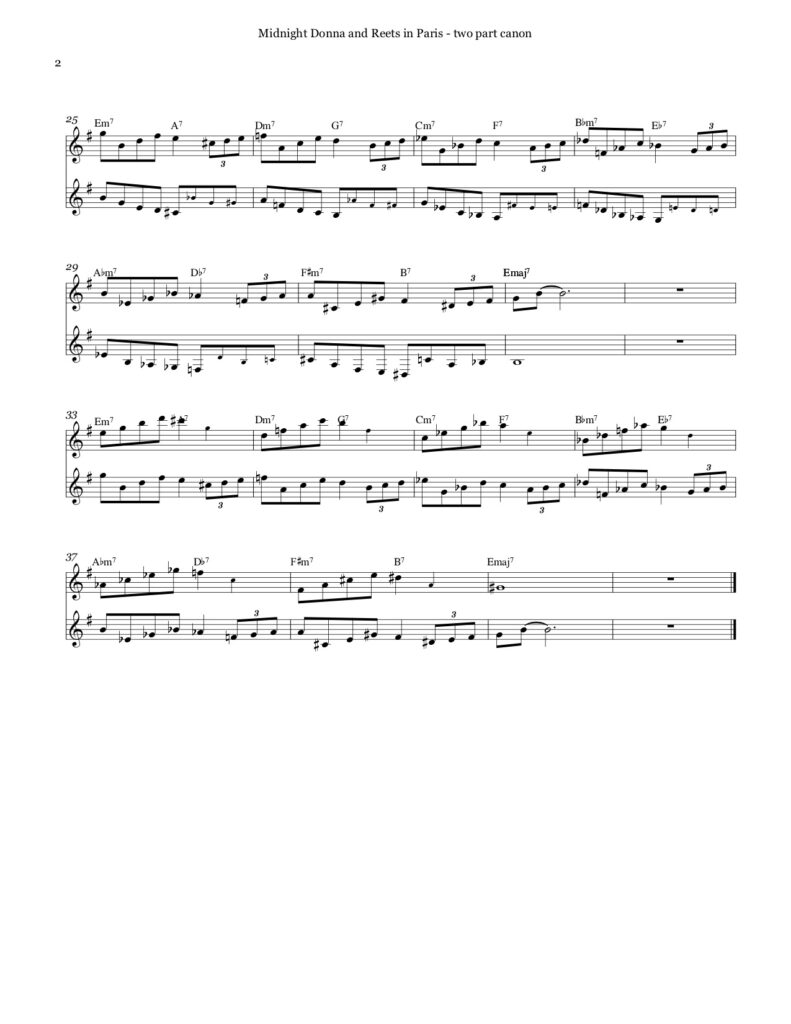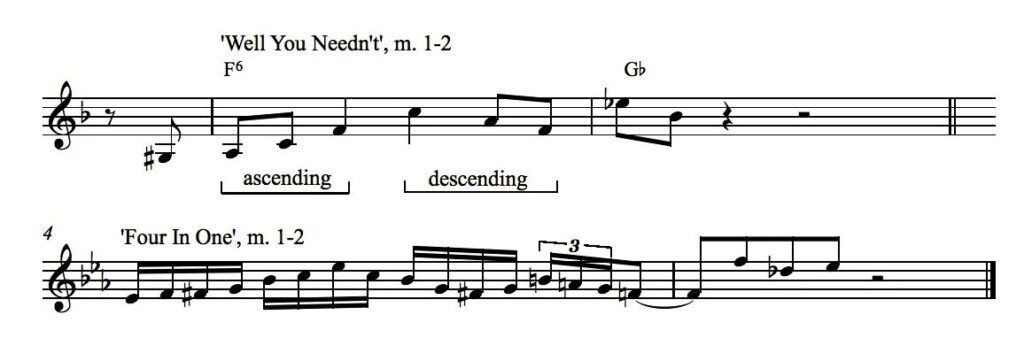This post starts with an exercise showing how typical jazz piano chord voicings for the one-bar ii-V progression are also expressed ‘horizontally’ in melodic patterns from classic bebop lines. Below the exercise are some thoughts on how the use of melodic patterns based on chord voicings in bebop lines seems related to the interest of many great jazz players in respellings of words (such as backwards spellings and anagrams), particularly in their tune titles.
The exercise below is based on licks which I associate with classic bop lines; however, as the links in this paragraph show, the usefulness of these licks can be seen in how widely they were borrowed, and continue to be borrowed, in the jazz community. The lick sequenced in m. 1-8 is based on measure 3 of Thelonious Monk’s Round Midnight. (This lick can also be heard in the intro to the 1954 pop hit ‘Mr. Sandman’, and in expanded versions on the bridge of John Coltrane’s ’26-2′ and near the beginning of Esperanza Spalding’s ‘Earth to Heaven’.) The lick in m. 9-16 is from the third to last bar of ‘Donna Lee’ (an example of a ‘convex’ one-bar ii-V pattern), which I see as based on an ‘off the 3rd’ voicing of the B flat minor 7th chord (or what Phil Degreg calls the ‘B voicing’.) Measures 17 to 24 show a pattern which appears in the Benny Harris tune ‘Reets and I’, played by Bud Powell on ‘The Amazing Bud Powell Volume 2.’ (Similar but more diatonic versions of the lick appear in two earlier tunes, Powell’s Strictly Confidential and in the bridge of Jimmy Giuffre’s Four Brothers.) Measures 25 to 30 show a pattern adapted from the John Lewis tune ‘Afternoon in Paris’. (This tune was first recorded by Lewis with Sonny Stitt and J.J. Johnson in 1949, and the lick seems to have originated from an earlier tune, Charlie Parker’s Marmaduke, which Parker recorded with Lewis on piano.) Each lick is transposed down by whole steps through six keys. The title of the exercise, ‘Midnight Donna and Reets in Paris’, is a way to remember the order of the licks in the exercise.
This exercise can also be played as a two-part canon by two hands on the piano (two hands of a single player, or two players each playing one hand of a duet), or by any pair of instruments or voices, particularly those which include one of higher register and one of lower register. The canon is written for the higher instrument to start and the lower instrument to follow, but as I mention in the instructions on the sheet, the parts can also be reversed so that the lower instrument starts. Pianists who find it challenging to coordinate right hand lines and left hand chords should concentrate on the first exercise, as this is a more basic jazz piano skill. The second exercise may be more appropriate for pianists with some experience at other contrapuntal pieces, such as J.S. Bach’s two-part inventions and Charlie Parker’s ‘Ah-Leu-Cha’ and ‘Chasin’ The Bird’. Composed contrapuntal lines like these Parker heads, and contrapuntal improvisation such as that heard near the end of Louis Armstrong’s rendition of ‘When The Red, Red Robin’ is a subgenre within jazz, much less common than the typical situation of a single melodic line with chordal accompaniment . A more recent development is jazz pianists who improvise two contrapuntal lines, one in each hand, such as in Brad Mehldau’s rendition of ‘Martha My Dear’ and Fred Hersch’s version of ‘Whisper Not’ from his solo album ‘Open Book’.

In the 2010 thriller movie ‘Shutter Island’, Leonardo DiCaprio plays Edward Daniels, a U.S. Marshal who is plagued by nightmares about an arsonist named Andrew Laeddis, Later in the movie, it is revealed that the names ‘Edward Daniels‘ and ‘Andrew Leaddis‘ are anagrams of each other, created by a mysterious mastermind. In other words, the two proper name/surname pairs share the same group of letters, and one was created by rearranging the letters of the other. (To find out which name came first, watch the movie, or in a pinch, read the Wikipedia entry.) Anagrams were a common interest among at least three great jazz piano masterminds: Thelonious Monk, Horace Silver and Bill Evans.
According to Robin D.G. Kelley’s biography ‘Thelonious Monk: The Life And Times Of An American Original’, the title of the tune ‘Eronel’, usually attributed to Monk, is a reverse spelling of ‘Lenore’, the one-time girlfriend of one of the tune’s principal authors, the pianist Sadik Hakim. (By Kelley’s account, Hakim wrote the melody with Idrees Sulieman and Monk later added some characteristic touches.) Kelley also mentions Monk had a black onyx ring inscribed with the word ‘MONK’, which he liked to point out could be read as ‘KNOW’ when viewed upside down. Horace Silver titled one of his compositions, ‘Ecaroh’, with a reverse spelling of his name, and also used the same word to name his publishing company. Bill Evans named two modal tunes with anagrams of friends’ names: ‘Re: Person I Knew’ (Orrin Keepnews) and ‘N.Y.C.’s No Lark’ (an elegy for Sonny Clark). Sonny Rollins encoded the word ‘Nigeria’ by spelling it backwards in the title of his composition Airegin, and Barry Harris created an African-sounding word by spelling Art Tatum’s name backwards in the title of ‘Mutattra’ (from Listen To Barry Harris.) Wordplay also continues to be a common form of humor among rank-and-file working jazz musicians (sometimes called ‘club date musicians’); it is not uncommon for ‘In A Sentimental Mood‘ to be referred to as ‘In A Semi-Mental Mood’.
It is only natural that these player/composers would title their songs with coded words, given that the musical language in which they composed and improvised, called ‘Bebop’ after the Dizzy Gillespie tune of the same name, was originally conceived as a kind of musical code, a private language which could only be spoken by those in the know. In bebop, often the tunes themselves were musical puzzles, concentration exercises designed to separate the hip from the square. In his biography Wail: the Life of Bud Powell, Peter Pullman notes that at Minton’s Playhouse, one of the venues where bebop was developed, the tune ‘Epistrophy’ (another Monk collaboration, this time with Kenny Clarke and Charlie Christian) ‘was one of the pieces used to keep the uninitiated off the bandstand’. (In this tune, Monk works a mind-bending variation on the 32 bar song form. Where most tunes of this length open with two identical, similar or contrasting eight-bar phrases, the first 16 measures of Epistrophy contain four-bar phrases arranged palindromically – A,B,B,A – which forces the improviser to ascend and descend a symmetrical harmonic ‘hill’ at the beginning of each chorus before they can reach the more traditional bridge and last A.) There is a parallel between the way that bop players (or those influenced by bop) were sometimes inclined to build song titles out of alternate spellings of words and the way that they often gave their melodic lines a cryptic aspect by using multiple ‘spellings’ or arpeggiations of chords. In a number of Monk tunes, a short melodic figure is immediately followed by an altered repetition of it. ‘Well You Needn’t’ opens with an ascending arpeggio of F major immediately followed by a descending one, and ‘Four In One’ opens with an ascending major blues scale followed by a descending one that comes within two notes of being an exact retrograde: 
A fun variant on these kinds of opposite-motion melodic lines are mirror exercises on piano, which have been discussed both by Harold Danko in a Keyboard Magazine column and Chick Corea in a recent online video ‘lesson’. Chick’s video reminded me of how I discovered at one point that both Monk’s ‘Straight No Chaser’ and Tadd Dameron’s ‘Hot House’ can be harmonized with mirror (i.e. inverted) counterpoint. (Other examples of ‘found counterpoint’ – countermelodies derived from an altered version of the original tune – include the Modern Jazz Quartet’s canonic version of ‘Bags’ Groove’, and Fred Hersch’s canonic arrangement of ‘Bemsha Swing’;these led me to discover that the Dizzy Gillespie tune ‘Bebop’ also works as a canon.) In contrast to the immediate reversals and respellings in the Monk tunes cited above, Jimmy Giuffre’s ‘Four Brothers’ and John Lewis’ ‘Afternoon in Paris’ both feature different spellings of the same chord within their first eight measures. This abundance of arpeggiation is necessary because chords lasting only two beats occur frequently in these tunes, and in bebop, arpeggiation is a common strategy for melodically navigating two-beat chord changes. Most of the two beat changes in ‘Four Brothers’ and ‘Afternoon In Paris’ belong to one-bar major ii-V progressions. A major ii-V progression is defined by two important characteristics: a minor 7th chord is followed by a dominant 7th chord, and there is the interval of an ascending fourth between the roots of the two chords. In the Barry Harris system, the two chords in the one bar major ii-V progression (i.e. one where each chord lasts two beats) can be outlined with a single ascending seventh scale (using the ‘seven up’ pattern) or a single descending seventh scale (using the ‘seven down’ pattern).  Barry Harris’ scalar approach to the ii-V can be contrasted with the more intervallic, arpeggiated approach to the one-bar ii-V progression in the melody to ‘Four Brothers’, which navigates the one-bar major ii-V with a melodic pattern that might be called the opposite-motion arpeggio. The A section begins with what could be called a ‘convex’ ii-V pattern (an ascending arpeggio of a ii chord voicing countered with a descending arpeggio of the V); and the bridge includes a ‘concave’ shape.
Barry Harris’ scalar approach to the ii-V can be contrasted with the more intervallic, arpeggiated approach to the one-bar ii-V progression in the melody to ‘Four Brothers’, which navigates the one-bar major ii-V with a melodic pattern that might be called the opposite-motion arpeggio. The A section begins with what could be called a ‘convex’ ii-V pattern (an ascending arpeggio of a ii chord voicing countered with a descending arpeggio of the V); and the bridge includes a ‘concave’ shape. 
The one bar minor ii-V progression shares some of the same characteristics as the major ii-V, with two alterations: the minor 7th chord is now a minor 7 flat five (a.k.a. half diminished) chord, and the dominant chord has at least one alteration, a lowered ninth (i.e. ‘flat nine’), sometimes accompanied by or replaced by other alterations including sharp five. Barry Harris‘ approach to the one bar minor ii-V progression is to apply the seventh scale from a major third below the root of the half-diminished ii chord, either with the ‘seven up’ pattern, or the ‘seven down’ pattern. With the ‘seven down’ pattern, the last note in the scale is raised a half step to form what I refer to in another blog post as the ‘seven down to the third’ scale.  This seemingly abstract approach to the minor ii-V is consistent with the many accounts of Monk’s description of the half diminished chord: according to Kelley, he always called the first chord in the introduction to ‘Round Midnight’ ‘C minor sixth with A in the bass’ rather than ‘A minor seven flat five’. In this context, Harris is taking the same approach to the ‘minor sixth’ here as he takes to the minor 7th chord in the major ii-V.
This seemingly abstract approach to the minor ii-V is consistent with the many accounts of Monk’s description of the half diminished chord: according to Kelley, he always called the first chord in the introduction to ‘Round Midnight’ ‘C minor sixth with A in the bass’ rather than ‘A minor seven flat five’. In this context, Harris is taking the same approach to the ‘minor sixth’ here as he takes to the minor 7th chord in the major ii-V.
Hi Reggie – Thanks for the question. My only point about Afternoon in Paris and Four Brothers is that in the first eight measures of both tunes, one sees two different arpeggiations of the same chord. In Afternoon in Paris, the first bar along with its pickup implies 4th inversion of Cmaj7, while the turnaround pattern in bar 7 (not included in the 5th edition Real Book that I first learned it from, but present in every recording I’ve heard) begins with a root position Cmaj7 arpeggio. (Incidentally, in the changes you list, the ‘D7’ in bar 8 should be a minor 7th chord, followed by a G7.) In Four Brothers, the melody in bar 2 implies a 3-5-7-9 voicing of the ii7 chord, while the melody in bar 5 implies a root position voicing of the same chord. Again, thanks for the opportunity to clarify this.
C7 | C-7 F7 | Bb | G7 |Cm7|Dm G7| Cm F7|Bb G7
Cmaj| Cm7 F7| Bb| Bbm Eb7|Ab | Dm7 G7|C | D7
Above are the changes to Four brothers then below Afternoon in Paris. Where are the variant spelling of the ‘same changes over four bars ‘ with different names? As I dont see it anywhere.